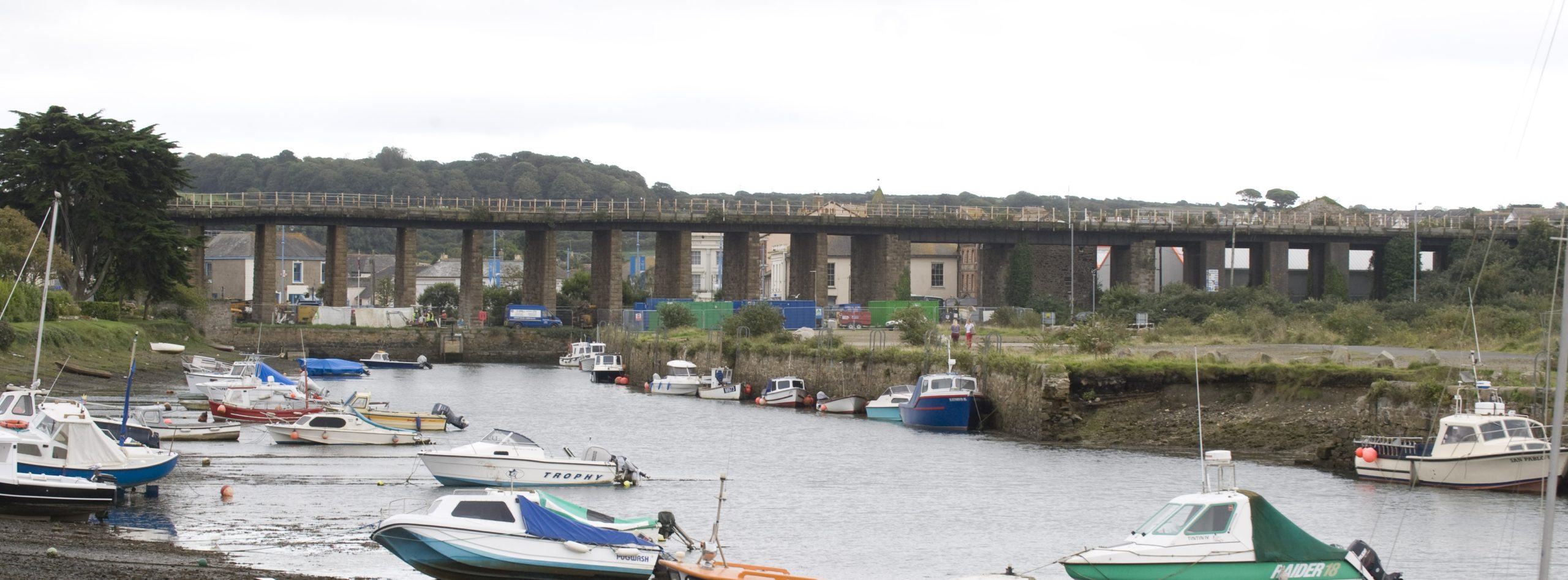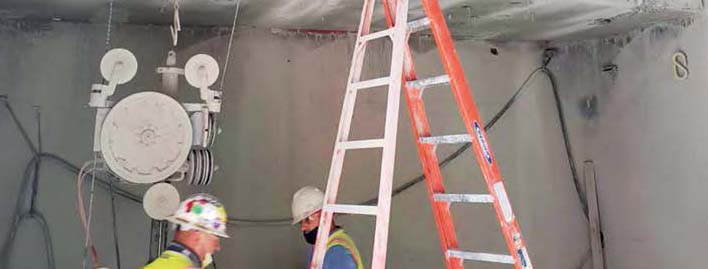
Strong to the Core

Diamond Drilling Strengthens Viaduct
A CSDA member in the United Kingdom was called in to help save a historic engineering masterpiece and keep a busy railway line in operation.

Operators cored 128 holes to a depth of 1.5 meters (4.9 feet).
In recent years, four of the piers at the Hayle Viaduct in southwest England had been affected by subsidence. These piers lie in the original creek bed at the center of the historic town of Hayle in Cornwall. To stop the viaduct piers from subsiding any further, action had to be taken. CSDA member D-Drill Master Drillers Ltd. of Coventry was selected by the main contractor, Bam Nuttall, to complete the technical task of drilling 128 holes through the structure using diamond core drills.
The 1.5-meter-deep (4.9-foot) holes were created in the granite piers for the installation of structural support I beams. Holes measuring 152 millimeters (6 inches) in diameter were overlapped to form 16 ‘I-shaped’ openings, created to allow just a 20-millimeter (0.8-inch) void between the beam to the structure. To make the task more challenging, the piers were twisted and in a curve, meaning all 128 holes were to be angled. In addition, the surface of the piers was uneven, so the mounting of core drills rigs was made all the more difficult. Due to the condition of the piers, the contractor could only work on one pier at a time. Working on multiple piers at once would have compromised their structural integrity.
The original Hayle Viaduct was designed by engineer Isambard Kingdom Brunel, a key figure in the country’s industrial revolution and one of its most revered engineers of all time. The viaduct opened in 1852 and was originally a wooden structure before later being replaced with granite. It has a total of 36 arches, measures 253 meters long (831 feet) and stands 10 meters high (34 feet). Today, the Cornish Main Line runs through Hayle and the viaduct is a vital part of this 80-mile rail line, connecting major towns and cities across the southwest region of England.
D-Drill had worked with the general contractor previously on a bridge cut-off project. The success of that project was an influence on the company being chosen for this job. Alastair Morley, project manager for Bam Nuttall, said,
“D-Drill was involved in the early stages of this scheme, assisting with development and feasibility studies. The project managers gave their professional advice to ensure the successful planning of the works. Together, we resolved a solution to core eight smaller holes in a pattern, rather than one large core, which vastly reduced the risk of damage to the viaduct.”

The uneven surfaces of the granite piers presented a challenge to the contractor.
Due to the varying angles of each pier, careful calculations had to be made by D-Drill’s team to make sure holes lined up to the positions marked by the general contractor. Any miscalculation would have caused problems for those grouting the 3-meter (9.8-foot) metal beams, so all drilling tasks were consistently monitored and reviewed throughout the project. The main problem involved with drilling deep holes, is retrieving the center of the core to continue drilling with bit extensions. Ed Taylor, project manager for D-Drill, had custom 1-meter-long (3.3-foot) bits manufactured, which allowed operators to complete each hole with just one bit change. Operators first used a 500-millimeter (1.6-foot) bit then retracted it, removed the core and attached the longer bit to reach the required depth.
Setting up on the uneven pier surfaces required experience and logical thinking, along with the use of wedges, plates and soldiers of wood to achieve the correct angle. Failure to set up correctly would have caused the bit to either rub on the side of the hole or dislodge the fixing, forcing a reset of the rig.
“This type of sensitive project required equipment with minimal vibration to avoid causing further damage to the piers. The depth of the material also left us with few options regarding methods, so the plan was to use our very best operators with custom-manufactured bits and rig extensions. Due to the tight tolerances required for the work, we decided that core drilling would give us the control and precision needed to get it right,” said Taylor.
First, a measurement was taken from the base and center of the opening at a distance of 343 millimeters (13.5 inches) vertically. This was the shortest distance in the slot on the base plate and allowed operators to drill one hole either side of the first. This meant that three holes could be created from one setup, saving time, cost of anchors and made the whole process more accurate. A 16-millimeter-diameter (0.6-inch) hole was drilled to a depth of 51 millimeters (2 inches) to house a Hilti drop-in anchor and a fixing bar was inserted and tightened to the thread of the anchor. The diamond drilling rig stand was fixed to the wall with the fixing bar penetrating the base plate of the drill stand. Final measurements were calculated and double-checked before some retightening.

An ‘I-shaped’ configuration was made by making eight 152-millimeter-diameter (6-inch) openings.
Drilling of the first hole commenced using the 500-millimeter (1.6-foot) tube and the DD350’s slow start mechanism was utilized to prevent the bit segments from dislodging in the uneven granite surface. When the bit reached maximum drilling depth, the motor and bit were removed from the rig and the granite center broken out. This allowed the operator to attach the 1-meter (3.3-foot) bit and continue drilling to the specified depth. The whole process took approximately 40 minutes. On completion of the first hole, the fixing nut was loosened enough to rotate the stand to overlap the hole by approximately a quarter for the next one. Due to the remote location of the site, D-Drill provided its own generators but was able to tap into the site office’s water supply for use while cutting.
D-Drill’s operations attracted quite an audience, as local residents watched the historic structure undergo essential strengthening work. To protect onlookers and keep them a safe distance from the work, a fence was erected by the general contractor. Within the work area, the drilling team was provided with all necessary personal protective equipment to complete the work safely. In addition, the opposite side of the cutting face was cordoned off to protect other onsite personnel.
The whole task took a total of 20 working days with two separate teams completing an average of 13 holes a day, drilling 19.5 meters (64 feet) of 152-millimeter-diameter (6-inch) holes through solid granite with three Hilti DD350 core drills. Operators worked to 10-millimeter (0.4-inch) tolerances to leave just 20 millimeters (0.8 inches) of void space in all 128 holes. The project was completed on time and within budget.
Supervisor and operator Jason Brown was given special recognition for his efforts on this project. “Jason has completed the U.K.’s Drilling and Sawing Association apprenticeship scheme and has been with D-Drill for a number of years. His attention to detail at the Hayle Viaduct was exemplary,” said Taylor. “I sent my two most experienced men to complete the job but couldn’t help getting on the tools myself for some of the work. This job was so interesting and challenging, it felt like it became part of the history of this site!” he added.
The success of this project, coupled with the bridge cut-off project completed a year earlier, has led to the drilling contractor working closely with the general contractor on other similar projects.
“D-Drill worked to complete 128 core holes, moving between the four piers in sequence. They worked with efficiency, managing the project with skilled operators and performed to our satisfaction. This ensured effective completion of all tasks within the agreed timescales,” concluded Morley.
Company Profile
D-Drill Master Drillers Ltd. has been a member of CSDA for 32 years and has been in business since 1967. Based in Coventry, England, the company has 94 employees and 70 trucks in 10 locations across the country. D-Drill offers services that include core drilling, slab sawing, wall sawing, hand sawing, wire sawing, controlled demolition, diamond floor grinding and floor preparation services.
Resources
General Contractor:
Bam Nuttall
Sawing and Drilling Contractor:
D-Drill Master Drillers, Ltd.
Coventry, United Kingdom
Phone: 44-1752 341364
Email: edtaylor@d-drill.co.uk
Website: www.d-drill.co.uk














